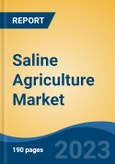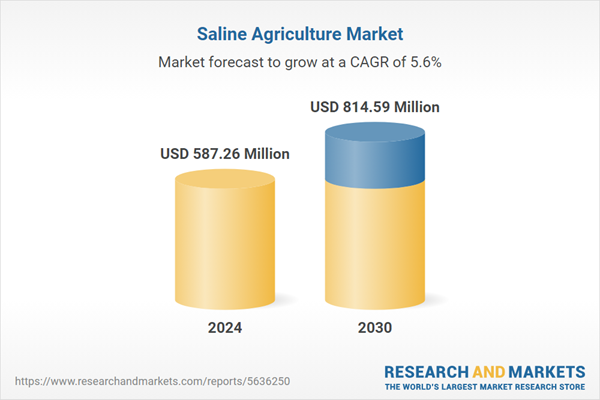Free Webex Call
Global Saline Agriculture Market was valued at USD 587.26 Million in 2024 and is expected to reach USD 814.59 Million by 2030 with a CAGR of 5.61% during the forecast period. Saline agriculture, also known as salt-tolerant agriculture or halophyte farming, is an innovative and sustainable approach to cultivating crops in saline or salt-affected soils. It involves the careful selection and cultivation of salt-tolerant plant species (halophytes) that have evolved unique mechanisms to thrive in high salinity environments, which are typically considered unsuitable for traditional agriculture. These remarkable crops have adapted to absorb and tolerate salt, making them resilient to the challenging conditions of saline soils. Speak directly to the analyst to clarify any post sales queries you may have.
10% Free customizationThis report comes with 10% free customization, enabling you to add data that meets your specific business needs.
By harnessing the power of halophytes, saline agriculture presents a viable solution to combat soil degradation and increase food production in arid and coastal regions worldwide. Additionally, this approach allows for the utilization of marginal lands that would otherwise be unused, reducing the pressure on freshwater resources and promoting sustainable land management practices. Implementing saline agriculture holds great promise for addressing food security challenges in saline-affected areas, where traditional farming methods struggle to yield satisfactory results. By leveraging the inherent resilience of halophytes, we can unlock the potential of these overlooked environments and contribute to a more sustainable and secure future for agriculture.
Key Market Drivers
Technological Advancements in Saline Agriculture Techniques
Technological advancements in saline agriculture techniques are poised to significantly increase global demand for salt-tolerant crop cultivation. Innovative solutions, such as the creation of genetically engineered salt-tolerant crops and the development of precision farming technologies, are revolutionizing the agricultural industry. These techniques permit the efficient utilization of saline soils and brackish water for farming, thereby increasing agricultural productivity in regions previously considered unsuitable for farming due to high salt content.Furthermore, the adoption of remote sensing technology and Geographic Information Systems (GIS) in saline agriculture allows for precise monitoring and management of saline soils, enhancing crop yield potential. The development of such technologies is also driving research in sustainable farming methods, attracting substantial investment in the agricultural sector. This, coupled with increasing concerns about food security in the face of a rapidly growing world population, is expected to propel the demand for saline agriculture globally. As such, the intersection of technology and saline agriculture points towards a future where agricultural productivity is no longer limited by the salinity of the soil, thereby paving the way for increased food production and a more food-secure world.
Key Market Challenges
High Levels of Soil Salinity
High levels of soil salinity are posing a significant threat to global agricultural productivity, potentially leading to a decrease in demand for saline agriculture. Soil salinity, caused by the accumulation of salts in the upper soil layers due to excessive evaporation in arid and semi-arid regions, has become a chronic issue. This accumulation adversely affects crop growth and yield, creating a hostile environment for most plants.The consequences include ion toxicity, osmotic stress, and nutrient imbalances, which limit the range of crops that can be successfully cultivated. Addressing this challenge requires substantial effort and resources. The process of desalinating soil is not only costly but also labor-intensive and time-consuming, making it a less attractive option for many farmers. Consequently, the global demand for saline agriculture is expected to decline.
Moreover, implementing sustainable farming practices such as crop rotation, proper irrigation management, and soil amendments can help improve soil quality and reduce the accumulation of salts over time. These practices not only mitigate the negative impact of soil salinity but also contribute to the long-term sustainability of agricultural systems. While high levels of soil salinity pose significant challenges to global agricultural productivity, there are viable and cost-effective solutions that can be pursued. By developing salt-tolerant crop varieties and adopting sustainable farming practices, we can overcome the limitations imposed by soil salinity and ensure the continued productivity of agricultural systems in saline-affected areas.
Key Market Trends
Increased Private Investment in Advanced Agricultural Technologies
Saline agriculture, the practice of using saline water for crop irrigation, is gaining global traction due to the rise in private investments in advanced agricultural technologies. Private sector players recognize the potential of saline agriculture in combating food security issues exacerbated by climate change and soil degradation. Such investments are fueling research and development into innovative farming techniques that leverage saline-tolerant crop varieties and precision irrigation systems. These technologies optimize the use of saline water, reducing the strain on freshwater resources and making agriculture viable in arid regions with high soil salinity.Furthermore, the integration of digital technologies in these systems allows real-time monitoring of soil health and water usage, thereby improving crop yield and quality. The rise in private investment is, therefore, expected to significantly drive the demand for saline agriculture globally. This trend reflects a broader shift towards sustainable and resilient agricultural practices, capable of navigating the challenges posed by climate change and rapid population growth. As more private entities invest in this sector, the adoption of saline agriculture is expected to grow, unlocking new opportunities for food production and contributing to global food security.
Key Market Players
- Seawater Solutions Ltd.
- Seawater Greenhouse
- Agrisea
- Seagrass Tech Private Limited
- Smart Floating Farms
- Blubrim Systmes
- Red Sea Farms
- Salt Farm Texel
Report Scope:
In this report, the Global Saline Agriculture Market has been segmented into the following categories, in addition to the industry trends which have also been detailed below:Saline Agriculture Market, By Water Source:
- Seawater
- Brackish Water
- Sewage
- Others
Saline Agriculture Market, By Technology:
- Saltwater Aquaponics
- Saltwater Hydroponics
- Saltwater
- Greenhouse
- Others
Saline Agriculture Market, By Crop Type:
- High Yielding Halophytes
- Oilseeds
- Fuel Wood & Timber
- Others
Saline Agriculture Market, By Application:
- Ornamental
- Environmental Protection
Saline Agriculture Market, By Region:
- North America
- United States
- Canada
- Mexico
- Europe
- France
- United Kingdom
- Italy
- Germany
- Spain
- Asia-Pacific
- China
- India
- Japan
- Australia
- South Korea
- South America
- Brazil
- Argentina
- Colombia
- Middle East & Africa
- South Africa
- Saudi Arabia
- UAE
Competitive Landscape
Company Profiles: Detailed analysis of the major companies present in the Global Saline Agriculture Market.Available Customizations:
With the given market data, the publisher offers customizations according to a company's specific needs. The following customization options are available for the report.Company Information
- Detailed analysis and profiling of additional market players (up to five).
This product will be delivered within 1-3 business days.
Table of Contents
1. Product Overview
2. Research Methodology
3. Executive Summary
5. Global Saline Agriculture Market Outlook
6. North America Saline Agriculture Market Outlook
7. Europe Saline Agriculture Market Outlook
8. Asia-Pacific Saline Agriculture Market Outlook
9. South America Saline Agriculture Market Outlook
10. Middle East and Africa Saline Agriculture Market Outlook
11. Market Dynamics
12. Market Trends & Developments
14. Porter’s Five Forces Analysis
15. Competitive Landscape
Companies Mentioned
- Seawater Solutions Ltd.
- Seawater Greenhouse
- Agrisea
- Seagrass Tech Private Limited
- Smart Floating Farms
- Blubrim Systmes
- Red Sea Farms
- Salt Farm Texel
Table Information
| Report Attribute | Details |
|---|---|
| No. of Pages | 185 |
| Published | March 2025 |
| Forecast Period | 2024 - 2030 |
| Estimated Market Value ( USD | $ 587.26 Million |
| Forecasted Market Value ( USD | $ 814.59 Million |
| Compound Annual Growth Rate | 5.6% |
| Regions Covered | Global |
| No. of Companies Mentioned | 8 |









